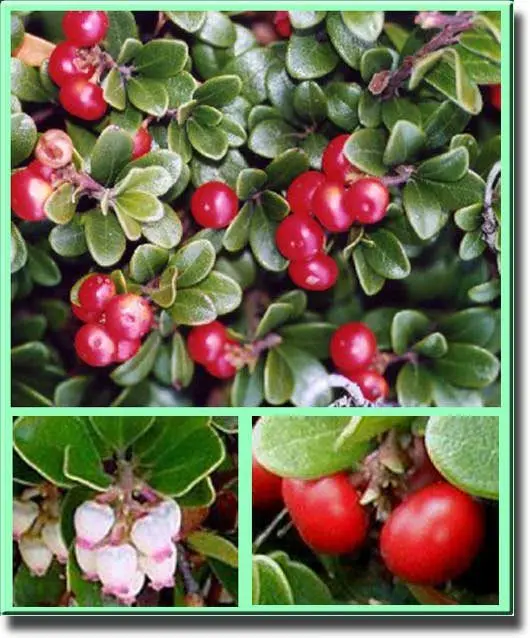Contents
Care, collection and application of the beneficial properties of bearberry
Botanical characteristics of bearberry

Bearberry is a perennial shrub that stays green all year round. The plant belongs to the heather family. The stem, growing no higher than 1,5 meters in height, strongly branches and spreads along the ground. The leaves of the plant are leathery and thick, with veins visible on the upper part. Bearberry flowers are whitish-pink in color, similar in shape to a water lily flower. After flowering (May-June), bright red fruits develop from the flowers. The bearberry berry tastes sour-tart. The fruits ripen in September.
Bearberry is often found in the Far East and Siberia. In addition to these places, the plant can be seen in any part of the CIS. Bearberry prefers dry and fresh sandy soils. This shrub grows in sunny places in forests, on clearings and separately from other plants.
Collection of bearberry
For medicinal preparations, bearberry shoots and leaves are used. Collect these parts of the plant in spring and autumn, namely before the flowering of the plant or after the fruit ripens. Branches with leaves in the summer season should be cut 3 cm long with a pruner or knife. It is impossible to pull out a plant with roots, because this will lead to the death of the entire thicket of the plant. The collected raw materials are stored in attics, where they dry. When the leaves are dry, they need to be cut off from the branches, and the branches are ground into powder. Properly dried raw bearberry will not smell. Bearberry is harvested most often in Belarus, the Leningrad region of Russia and in Kaliningrad.
Useful properties of bearberry
Bearberry has an antiseptic and anti-inflammatory effect. The plant has been successfully used as a diuretic. Bearberry contains tannins, due to which it has an astringent property that affects the gastrointestinal tract. Bearberry is recommended to be used as a bactericidal agent. And also the plant has a disinfectant effect in cystitis, pyelitis and urethritis.
Bearberry is used to reduce the myometrium, with whites, various sexually transmitted diseases and nervous disorders. The plant has an analgesic effect in rheumatism, wound healing – in ulcers and skin diseases.
The use of bearberry

Bearberry has long been used in folk medicine in the treatment of various diseases of the bladder and urinary tract. The plant is used in the preparation of fees intended for a diuretic effect. Bearberry powder is used for heartburn, gastritis and Graves’ disease. A decoction of bearberry is recommended for heart failure, edema, tuberculosis and uterine bleeding. Outwardly, bearberry is used in the form of baths, washings for purulent wounds and diathesis.
Bearberry tincture is used for diseases of the nervous system, insomnia and alcoholism. The plant has a good effect on a malignant tumor. Bearberry flowers are used for heart disease and pemphigus. Infusion and decoction of flowers help with conjunctivitis and blepharitis.
Infusion of bearberry for inflammation of the bladder. To prepare it, you need to take 2 teaspoons of the leaves of the plant and pour them with a glass of water. Leave the composition to brew for 1 day, then strain and take 200 ml three times a day in a warm form.
Bearberry collection. We mix the following herbs in one container, each 10 grams: bearberry and birch leaves, licorice root and horsetail grass. To this mixture we add 20 grams of lingonberry leaves, nettle grass and flax seeds. Now mix everything well and take 1 tablespoon of the collection. Pour a spoonful of collection with a glass of boiling water and put on fire for 15 minutes (in a water bath). Remove the remedy from the fire and insist for an hour. It is necessary to take the collection twice a day, 70 ml each.
Toloknyanka with cysts. Let’s take 20 grams of bearberry leaves, 5 grams of parsley and the same amount of celandine herbs. Add 20 grams of hernia grass and mix everything. Pour the finished mixture with a glass of boiling water, leave for 1 hour and take the finished broth three times a day, 50-70 ml each.
Collection of bearberry for insomnia. To prepare this collection, you need to mix bearberry leaves, birch leaves, licorice root and corn stigmas. All herbs are taken in equal quantities. 1 part of the collection is poured with 20 parts of boiling water. Take the collection as a sedative, antiseptic and diuretic three times a day before meals, 70 ml each.
Contraindications to the use of bearberry
People with acute kidney disease should limit themselves to the use of this herb. Fees from bearberry are allowed for every person. Bearberry should be consumed only in moderate doses, and if the doses are excessive, vomiting, diarrhea, nausea, and other side effects will appear.









